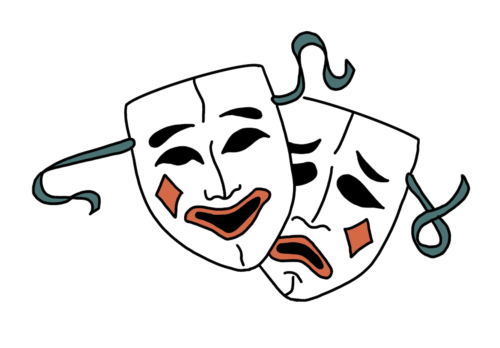Before I became a student, if you asked me to imagine what a weekday night would look like at Harvard, I definitely would not have told you I’d be in a South End theater watching seven women grapple with a media fiasco in the White House.
Attending the play POTUS was not just a spontaneous theatrical outing, but rather a requirement for my acting course—an example of experiential learning, where the outside world becomes the classroom. This teaching model is fairly prevalent at Harvard; the Mindich Program in Engaged Scholarship “supports innovations in teaching and learning through civically engaged experiential learning in or with community beyond the Harvard context,” offering a variety of courses across disciplines. These courses, available to students of all class years and concentrations, bring academic theories to life and make education at Harvard truly holistic.
My first-year seminar, The Art and Craft of Acting, takes students across Boston almost every Thursday night to watch plays, free of charge. Taught by Lecturer on Theater, Dance & Media Remo Airaldi, the class introduces students to a wide array of neighborhoods and exposes us to a variety of theatrical styles and stories. We’ve watched Greek and Yoruba mythology collide in The Half-God of Rainfall in Cambridge, political farce unfold in POTUS at the SpeakEasy Stage in the South End, and heartfelt letters by Rwandans come alive in The Book of Life in Downtown Boston.
A February 2015 study with Elon University students showed that increased experiential learning leads to better outcomes in both learning and career development, with a higher likelihood of post-graduation employment and graduate school acceptance for students who completed multiple units of experiential learning compared to students who pursued only one.
I have experienced the positive aspects of experiential learning firsthand in my acting class. Although I took acting courses in high school, watching professionals in action and connecting their choices to acting concepts from class is invaluable. After each outing, my classmates and I pen our thoughts in blog posts and reply to each other in the comments, deepening our understanding of acting through our shared experiences. The outcome is a unique sense of camaraderie among us that values and acknowledges everyone’s thoughts and perspectives about the play.
These immersive experiences are not confined to the arts. The Mindich course GENED 1093: Who Lives, Who Dies, Who Cares?, which focuses on society’s role in health inequities, offers a practical learning section as an alternative to usual discussion-based sections. Students in the engaged scholarship section work with healthcare organizations over 6-8 weeks to create projects “that allow them to explore and apply the biosocial principles and social theories learned in class,” as stated in the course syllabus.
Beyond the Mindich program, most class meetings of the first-year seminar “Tree” take place in Harvard’s Arnold Arboretum. The course matches each student up with a specific tree in the arboretum to observe throughout the semester. Likewise, HIST 1016: Immigration Law: A History of the Present, allows students to take part in an immigration court-watching project in lieu of a final paper.
Gabby Greene ’27 opted to participate in this project, traveling to the Boston Immigration Court to watch in-person hearings. The experience exposed her to a new perspective on the current state of immigration in the United States, as all the respondents she observed in court were asylum seekers from Brazil.
“I felt like in high school with my history courses, it was very one dimensional,” she said. “We were learning about important issues, but we weren’t actually getting to experience the legacy of those historic decisions in real-time. We were just learning about them in isolation through articles or the opinions and words of other people. But getting to experience it for myself and sit in a courtroom and observe and see what’s going on was really helpful for my learning, to apply what I’ve learned to real-life scenarios.”
Various writers in previous issues of the Harvard Independent have tackled the topic of the “Harvard bubble,” what some perceive as the closed-off nature of the Harvard community; Layla Chaaraoui ’26 discussed the potential for students to leverage the “bubble” and their privilege for societal good and Jude Herwitz ’25 argued the problem is not Harvard but a “broader American, Gen Z, 21st-century bubble” that induces feelings of disillusionment amid global challenges. In my view, experiential learning seeks to address both points. Immersing students in real-world situations broadens their perspective and combats feelings of paralysis or helplessness, empowering them to actively contribute to societal solutions.
Harvard could make information about courses with experiential learning components more accessible to students. Since the Mindich course list is not comprehensive, incorporating a filter into the Course Catalog would be especially helpful, ensuring students do not have to search through course descriptions and syllabi one-by-one to find classes with outside-the-classroom components.
Ultimately, it is the responsibility of the student body to seize these opportunities and break the confines of our own bubbles. We have to choose the experience-based assignments, projects, and sections over the traditional ones, journey to the Arboretum each week to see our trees, and sacrifice our time to enrich our learning experiences and bridge the gap between college and the real world. That way, we can come closer to crafting a Harvard experience that prepares us for the challenges and complexities of tomorrow.
Lucas Cohen-d’Arbeloff ’27 (lcohendarbeloff@college.harvard.edu) is taking three classes this semester that involve outside-the-classroom experiences.

